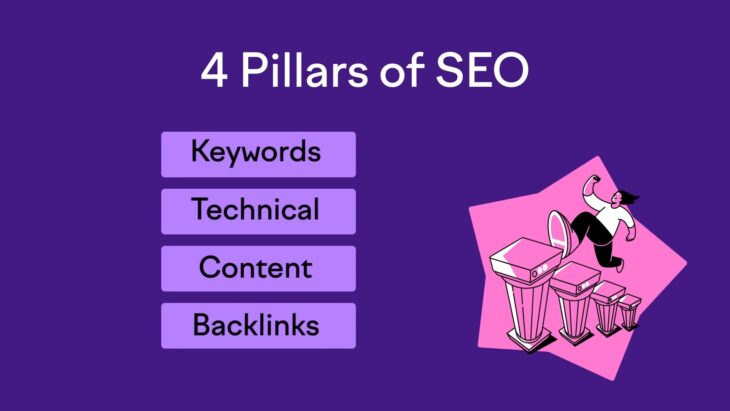Combining SEO and SEM is like unlocking a powerful synergy for your website’s visibility. With SEO’s focus on organic growth and SEM’s capability for quick visibility boosts, you’re essentially covering all bases.
It’s all about maximizing your reach and effectiveness in the online space, ensuring your website stands out amidst the competition. In the following sections, I will explain more about the proper use of SEO and SEM, and how they can help your business.
Table of Contents
ToggleWhy You Should Use Them Together?

Integrating organic and paid search strategies offers an advanced approach to digital visibility. This approach not only enhances your website’s rank but also brings a host of benefits that can significantly impact your business.
Enhanced Online Visibility
Combining these strategies ensures your brand appears more frequently across search results, capturing attention from a broader audience.
- Organic traffic improves your presence in long-term search results, establishing credibility and trust with your audience.
- Paid campaigns, on the other hand, offer immediate visibility, especially useful for targeting specific demographics or promoting time-sensitive offers.
Improved Website Traffic Quality
Using both organic and paid searches refines the quality of traffic to your site.
- Organic strategies attract visitors who are looking for content that matches their search intent, indicating a higher level of engagement and interest in what you offer.
- Paid search complements this by targeting specific keywords or demographics, drawing in traffic that is more likely to convert.
Cost-Effective Marketing
While paid campaigns require an upfront investment, their costs can be controlled and optimized for better ROI. Organic efforts, though requiring time and consistency, contribute to sustained traffic without the ongoing costs associated with paid ads.
Data-Driven Insights

The combination of both strategies provides a wealth of data that can inform and refine your marketing efforts.
- Analysis of organic search data reveals valuable insights into customer behavior and market trends, guiding content creation and website optimization.
- Data from paid campaigns offer immediate feedback on keyword performance and user engagement, allowing for rapid adjustments to maximize campaign effectiveness.
Competitive Advantage
A dual-strategy approach positions your business ahead of competitors who might rely solely on one method. It ensures your brand maintains visibility across a variety of search scenarios, safeguarding against changes in search algorithms that might affect organic visibility or fluctuations in advertising costs that could impact paid reach.
Improved Brand Authority
A consistent presence in both organic and paid search results reinforces your brand’s authority in your industry.
- High rankings in organic searches signal to users that your content is relevant and valuable, enhancing your brand’s credibility.
- At the same time, targeted paid ads can highlight your expertise in specific areas, further strengthening your reputation.
Synchronized Marketing Efforts
Integrating these strategies allows for a more cohesive marketing effort. Keywords and insights collected from one approach can inform the other, leading to a more unified and effective messaging strategy.
How to Get the Most Out of SEM?
Maximizing the potential of Search Engine Marketing (SEM) involves strategic planning, continuous optimization, and a keen understanding of your target audience.
Here are the essential strategies to implement for the best results:
Strategic Keyword Selection
- Detailed Research: Begin with thorough keyword research to identify terms that are not only relevant to your business but also have a high search volume and purchase intent. Utilize tools like Google Keyword Planner or SEMrush to gather data.
- Long-Tail Keywords: Incorporate long-tail keywords into your campaigns. These longer, more specific phrases often have lower competition and can attract more qualified leads.
Targeted Ad Campaigns
- Segmentation: Create ad campaigns that are highly targeted to specific segments of your audience. Tailor your ads based on demographics, location, behavior, or interests to increase relevance and engagement.
- Ad Extensions: Use ad extensions to provide additional information and improve your ad’s visibility and click-through rate (CTR). Extensions can include site links, call buttons, location information, and more.
Landing Page Optimization
- Relevance: Ensure that each ad leads to a landing page that closely matches the searcher’s intent and the ad’s promise. The relevance is crucial for maintaining user interest and increasing conversion rates.
- User Experience: Optimize landing pages for a smooth user experience, with fast load times, mobile responsiveness, and clear calls-to-action (CTAs).
Continuous Testing and Optimization

- A/B Testing: Regularly test different elements of your ads and landing pages, such as headlines, descriptions, and CTAs, to determine what works best.
- Bid Adjustments: Continuously monitor and adjust your bids to ensure that you’re competitive for your targeted keywords without overspending.
Analytics and Insights
- Performance Analysis: Use analytics tools to track the performance of your campaigns, analyzing metrics like CTR, conversion rate, and cost per conversion.
- Insight Application: Apply insights from your analytics to refine and improve your campaigns. Identify high-performing keywords and ad formats and allocate more budget to them.
Stay Updated With SEM Trends
- Industry Updates: Keep track of the latest trends and updates in SEM, including changes to search engine algorithms and new ad features.
- Competitive Analysis: Conduct a competitive analysis to understand the strategies employed by your competitors.
| Strategic Keyword Selection | Focus on relevant, high-volume keywords and incorporate long-tail variations. |
| Targeted Ad Campaigns | Segment your audience and use ad extensions to enhance ad information and visibility. |
| Landing Page Optimization | Ensure relevance and a seamless user experience on landing pages linked to ads. |
| Continuous Testing and Optimization | Perform A/B testing and adjust bids based on performance data. |
| Utilize Analytics and Insights | Analyze campaign data to refine strategies and allocate budget efficiently. |
| Stay Updated With SEM Trends | Keep informed about industry changes and conduct competitive analysis. |
Why is SEO Essential?

It helps your website show up more often and get more visitors from search engines. With the right approach, SEO can boost your business and make it more successful online.
Here are the key factors that must be part of your SEO strategy.
Build Organic Visibility
- Higher Search Rankings: By optimizing your website with relevant keywords, quality content, and a user-friendly structure, you can achieve higher rankings in search engine results pages (SERPs).
- Sustainable Traffic: Unlike paid advertising, the traffic generated through SEO is sustainable over the long term, reducing dependency on paid sources.
Improve User Experience
- Website Optimization: SEO involves optimizing your website’s layout, speed, and content, making it more appealing and accessible to users. A well-optimized website encourages longer visits and higher engagement rates.
- Mobile Responsiveness: With the increasing use of mobile devices for web browsing, ensuring your website is mobile-friendly is crucial. SEO practices emphasize mobile optimization, catering to a broader audience.
Build Credibility and Trust
- Authority Building: Websites that appear higher in search results are often perceived as more trustworthy and authoritative by users. SEO helps in establishing your site’s authority through backlinks, content quality, and user engagement metrics.
- Brand Awareness: Consistent visibility in search results helps in building brand awareness. Users are more likely to trust and recognize a brand that frequently appears in their search queries.
- EEAT Evaluation: SEO also involves demonstrating your website’s experience, expertise, authoritativeness, and trustworthiness (EEAT) to both users and search engines. A high-EEAT website provides accurate, reliable, and relevant information from credible sources.
It is More Affordable
- ROI: SEO is known for its cost-effectiveness. While it may require an upfront investment, the long-term returns in terms of increased traffic and conversions can significantly outweigh the initial costs.
- Targeted Traffic: SEO allows you to target users who are actively searching for information related to your products or services, leading to higher conversion rates.
Some of these strategies require advanced skills and experience. If you need an assistance, you can always hire a professional agency like InterCool Studio.
The Only Way to Deal With Competition
- Competitive Edge: Having a complex SEO strategy is essential to stand out among competitors. It ensures that your website maintains its visibility and ranking above others.
- Adaptability to Algorithm Changes: Regular updates to SEO strategies can help your website adapt to frequent changes in search engine algorithms, ensuring sustained visibility.
The best way to ensure staying up to date with all changes is to follow news and use additional tools like Semrush, Ahrefs, and Moz.
| Building Organic Visibility | Increases website’s search rankings and sustainable traffic without ongoing costs. |
| Enhancing User Experience | Improves website layout, speed, and mobile responsiveness, leading to higher user engagement. |
| Building Credibility and Trust | Establishes authority and brand awareness through higher search result placements. |
| Cost-Effectiveness | Delivers a high ROI by targeting users actively searching for related products or services. |
| Keeping Up with Competitors | Ensures a competitive edge and adaptability to search engine algorithm changes. |
FAQs

Why do we need SEM?
SEM (Search Engine Marketing) is a way to get more visibility and traffic from search engines through both organic and paid methods. SEM can help you reach potential customers who are looking for your products or services at the right time and place.
How does Google Analytics help SEO and SEM?
Google Analytics is a tool that can help you measure and improve your SEO and SEM performance. You can use Google Analytics to track various metrics, such as organic and paid traffic, conversions, bounce rate, keywords, landing pages, and more.
How can I increase my SEM traffic?
You can increase your SEM traffic by optimizing your SEO and PPC strategies. For SEO, you should focus on keyword research, on-page SEO, off-page SEO, and technical SEO. For PPC, you should focus on bidding, targeting, ad copy, landing pages, and quality score.
Is it better to invest in SEO or SEM?
There is no definitive answer to this question, as it depends on your goals, budget, industry, and competition. However, a general rule of thumb is that SEO is a long-term investment that can bring you sustainable and organic traffic, while SEM is a short-term investment that can bring you immediate and paid traffic. Ideally, you should use both SEO and SEM to complement each other and maximize your results.
Summary
SEO and SEM work best when they work together. SEO helps your website grow organically and earn the trust of your audience. SEM helps your website get seen quickly and reach the right people.
They both help you get more online exposure, attract more visitors, and convert them into customers.



